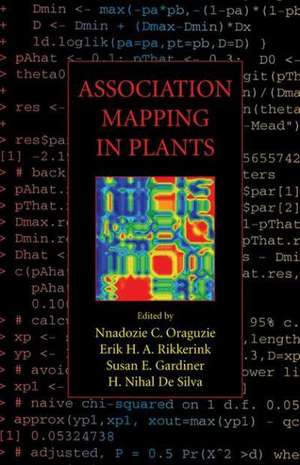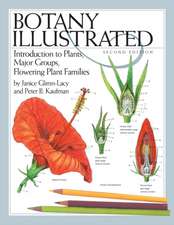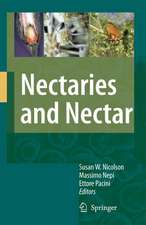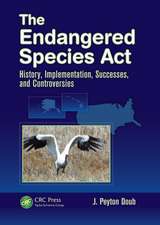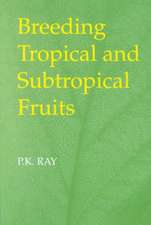Association Mapping in Plants
Editat de Nnadozie C. Oraguzie, Erik H.A. Rikkerink, Susan E. Gardiner, H. Nihal de Silvaen Limba Engleză Paperback – 22 noi 2010
Association Mapping in Plants provides both basic and advanced understanding of association mapping and an awareness of population genomics tools to facilitate mapping and identification of the underlying causes of quantitative trait variation in plants. It acts as a useful review of the marker technology, the statistical methodology, and the progress to date. It also offers guides to the use of single nucleotide polymorphisms (SNPs) in association studies.
| Toate formatele și edițiile | Preț | Express |
|---|---|---|
| Paperback (1) | 784.91 lei 38-44 zile | |
| Springer – 22 noi 2010 | 784.91 lei 38-44 zile | |
| Hardback (1) | 949.10 lei 6-8 săpt. | |
| Springer – 5 dec 2006 | 949.10 lei 6-8 săpt. |
Preț: 784.91 lei
Preț vechi: 1032.77 lei
-24% Nou
Puncte Express: 1177
Preț estimativ în valută:
150.21€ • 156.24$ • 124.01£
150.21€ • 156.24$ • 124.01£
Carte tipărită la comandă
Livrare economică 11-17 aprilie
Preluare comenzi: 021 569.72.76
Specificații
ISBN-13: 9781441922618
ISBN-10: 144192261X
Pagini: 296
Ilustrații: XIV, 278 p.
Dimensiuni: 155 x 235 x 16 mm
Ediția:Softcover reprint of hardcover 1st ed. 2007
Editura: Springer
Colecția Springer
Locul publicării:New York, NY, United States
ISBN-10: 144192261X
Pagini: 296
Ilustrații: XIV, 278 p.
Dimensiuni: 155 x 235 x 16 mm
Ediția:Softcover reprint of hardcover 1st ed. 2007
Editura: Springer
Colecția Springer
Locul publicării:New York, NY, United States
Public țintă
ResearchCuprins
An Overview of Association Mapping.- Linkage Disequilibrium.- What Are SNPs?.- Single Nucleotide Polymorphism Discovery.- Single Nucleotide Polymorphism Genotyping in Plants.- SNP Applications in Plants.- Linkage Disequilibrium Mapping Concepts.- Statistical Analysis and Experimental Design.- Linkage Disequilibrium-Based Association Mapping in Forage Species.- Gene-Assisted Selection Applications of Association Genetics for Forest Tree Breeding.- Prospects of Association Mapping in Perennial Horticultural Crops.
Recenzii
From the reviews:
"Association mapping in plants is a timely, well-planned book that covers most topics related to association mapping in plants … as well as giving insights into the potential impact of association mapping in plant breeding programmes. … can be used both as an introductory book for students and as a manual to design experiments and analyse genetic association date by experienced researchers or breeding program managers. … In conclusion, we recommend Association mapping in plants as an excellent book to researchers and professionals … ." (Santiago C. González-Martínez and Delphine Grivet, Annals of Botany, Vol. 104 (6), November, 2009)
"Association mapping in plants is a timely, well-planned book that covers most topics related to association mapping in plants … as well as giving insights into the potential impact of association mapping in plant breeding programmes. … can be used both as an introductory book for students and as a manual to design experiments and analyse genetic association date by experienced researchers or breeding program managers. … In conclusion, we recommend Association mapping in plants as an excellent book to researchers and professionals … ." (Santiago C. González-Martínez and Delphine Grivet, Annals of Botany, Vol. 104 (6), November, 2009)
Notă biografică
Dr. Nnadozie C. Oraguzie is a Senior Scientist in Genetics at the Horticulture and Food Research Institute of New Zealand Ltd (HortResearch).
Dr. Erik H. A. Rikkerink is a Science Leader at HortResearch, New Zealand.
Dr. Susan E. Gardiner is a Principal Scientist and leader of the Gene Mapping research team at HortResearch, New Zealand.
Dr. H. Nihal De Silva is a Senior Scientist of Biometrics at HortResearch, New Zealand.
Dr. Erik H. A. Rikkerink is a Science Leader at HortResearch, New Zealand.
Dr. Susan E. Gardiner is a Principal Scientist and leader of the Gene Mapping research team at HortResearch, New Zealand.
Dr. H. Nihal De Silva is a Senior Scientist of Biometrics at HortResearch, New Zealand.
Textul de pe ultima copertă
For the past decade, there has been success in using conventional map-based strategies in identification and cloning of quantitative trait loci (QTL) in model plant species including tomato and Arabidopsis. These quantitative traits are generally the products of many loci with varying degrees of effect upon the observed phenotypes. Recently, a new approach to genetic mapping has emerged called association mapping. This new technique takes into account the thousands of genes to evaluate for QTL effect and is a more efficient approach that does not require generation of segregating populations/large numbers of progeny. As it can utilize all of the historic recombination events in a diverse population of individuals it can generate higher resolution genetic maps and, is needed to complement current map based cloning methods.
Association Mapping in Plants provides both basic and advanced understanding of association mapping and an awareness of population genomics tools to facilitate mapping and identification of the underlying causes of quantitative trait variation in plants. It acts as a useful review of the marker technology, the statistical methodology, and the progress to date. It also offers guides to the use of single nucleotide polymorphisms (SNPs) in association studies.
This book will appeal to all those with an interest in plant genetics, plant breeding, and plant genomics.
About the Editors:
Dr. Nnadozie C. Oraguzie is a Senior Scientist in Genetics at the Horticulture and Food Research Institute of New Zealand Ltd (HortResearch).
Dr. Erik H. A. Rikkerink is a Science Leader at HortResearch, New Zealand.
Dr. Susan E. Gardiner is a Principal Scientist and leader of the Gene Mapping research team at HortResearch, New Zealand.
Dr. H. Nihal De Silva is a Senior Scientist of Biometrics at HortResearch, New Zealand.
Association Mapping in Plants provides both basic and advanced understanding of association mapping and an awareness of population genomics tools to facilitate mapping and identification of the underlying causes of quantitative trait variation in plants. It acts as a useful review of the marker technology, the statistical methodology, and the progress to date. It also offers guides to the use of single nucleotide polymorphisms (SNPs) in association studies.
This book will appeal to all those with an interest in plant genetics, plant breeding, and plant genomics.
About the Editors:
Dr. Nnadozie C. Oraguzie is a Senior Scientist in Genetics at the Horticulture and Food Research Institute of New Zealand Ltd (HortResearch).
Dr. Erik H. A. Rikkerink is a Science Leader at HortResearch, New Zealand.
Dr. Susan E. Gardiner is a Principal Scientist and leader of the Gene Mapping research team at HortResearch, New Zealand.
Dr. H. Nihal De Silva is a Senior Scientist of Biometrics at HortResearch, New Zealand.
Caracteristici
A step beyond the conventional plant genetic techniques, this book will assist those who have thought about applying association mapping techniques in their research but haven’t been sure where to start Strong coverage of SNP’s will make this book stand out from the similar books on the market
